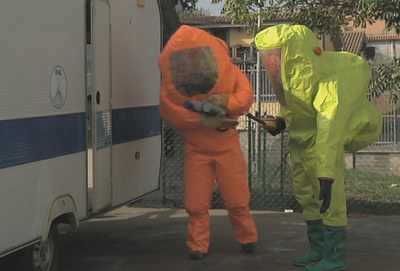Security: 100 experts from all over Europe on technologies to fight against terrorism
19/11/2015
Over 100 experts from the whole of Europe participated at a two-day event on technologies to prevent and counter acts of terrorism, organized by ENEA jointly with the German Research Organization Fraunhofer INT.
The simulated tests, as close as possible to real-life scenarios, were conducted at the ENEA Frascati Research Center and allowed to validate methodologies and innovative tools to contrast CBRNe (chemical, biological, radiological, nuclear and explosive) attacks.
 Besides representatives of Border Police, Radioprotection Institutes, Fire Department and other branches of the Military, the event drew participants from leading companies of the sector such as BAE Systems, coordinator of the European project EDEN, within which the two-day event took place.
Besides representatives of Border Police, Radioprotection Institutes, Fire Department and other branches of the Military, the event drew participants from leading companies of the sector such as BAE Systems, coordinator of the European project EDEN, within which the two-day event took place.
EDEN (End-user driven DEmo for cbrNE), with 36 million euro funding, is the largest ever EU funded project in the security field, linking universities, research organizations, major industries, SMEs and end-users from 15 EU Countries for a total of 36 partners among leading security experts.
One of the outcomes of the project is EDEN Store, an open platform for end users to enter and download innovative tools, procedures and applications for the prevention and mitigation of terrorist attacks. The Store makes available specific tools for responding to CBRNe events.
In particular, two possible terror scenarios were developed: the first tested the remote detection of explosive and radioactive material inside a vehicle, with which to fabricate a “dirty bomb”; the second involved a team with a vehicle to detect illegal radioactive material.
ENEA tested five different technologies:
- NAI (Neutron Active Interrogation), an innovative sensor using a neutron generator to remotely detect explosive and radioactive material;
- ILS (Integrated Laser System), a laser capable of detecting traces of explosives up to 100 metres away from the inspected target;
- PRASSI, a robot capable of carry out missions autonomously and allowing the use of the ILS laser in areas inaccessible to man;
- RGB-ITR, a laser to get the 3D model car in which potential terrorists placed “dirty bombs” It’s a technology previously used to acquire tridimensional images of art works such as the Sistine Chapel;
- RADCAL, a software capable of predicting the contamination effects of a dirty bomb explosion.
Next tests will concern nuclear safety and are scheduled to take place in April 2016 at the ENEA Casaccia Research Center, where large-scale demonstrations on emergency response will be conducted simultaneously with the Chernobyl area. In particular, innovative methods to ensure the safety of the population and the areas surrounding the site of an hypothetical nuclear incident and tests on the communication flows among states will be tested. Last stop will be Brussels military airport, hosting a major exhibition next year to illustrate the technological results obtained by all the partners involved in the three-year European project.
“Effective prevention and immediate response to those risks depend on the quality and reliability of the available technologies – Luigi De Dominicis, ENEA researcher, remarks – Our Agency has a leading role in developing innovative tools and in validating results”.
For more information please contact:
Luigi De Dominicis, ENEA Frascati Research Center, luigi.dedominicis@enea.it
